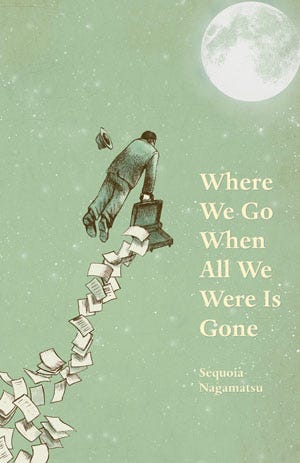
Relationships change, towns can develop, loved ones pass, and everyone searches for ways to cope when all they were is now gone. This coping — and not coping — fills the pages of Where We Go When All We Were Is Gone, by Sequoia Nagamatsu. A one-page transcript, mock-flyer, or even a recipe precedes each story and adds flavor and tone to every narrative. The stories take place in Japan, and many relate to Japanese pop culture, myths, and folktales. Even delving into the supernatural, these stories are relatable, centering on familiar relationships and problems: between couples, parents and children, and friends.
“The Return to Monster Land” is the first story in Nagamatsu’s book, which focuses on an unnamed scientist and widower and his daughter Ayu coping with the death of Mayu, their wife and mother who happened to be the lead scientist on kaiju. He shares field notes on kaiju to the public to share and continue his wife’s work. Peppered in between these records are sections detailing the life of this family and every flaw mixed in: the lack of love, hint of cheating, long distance relationship, and absence of a parent.
I never minded / being the one to chauffer Ayu, cook meals, help with homework, and read bedtime stories. But, if I’m honest, Ayu grew up only with / the mystique of her mother, the legend of her spun from letters and / occasional visits. . . . Mayu / became the giver of gifts, the adventurer with stories, the person my / daughter turned to for understanding when I became the target of / hatred.
Some might expect a story titled “The Inn of the Dead’s Orientation For Being A Japanese Ghost” to be morbid. It describes different ghosts, some of which are vengeful, others are people who died young or in horrible ways. Yet, one of the first lines is “Yes, I am Oiwa, / the grudge with never-ending hair, and I am the keeper of this Inn / of the Dead. Welcome!” as a cheery hello to the readers and the newly-departed. Notably, Nagamatsu wrote this story like a guide to a hotel or resort, including details and thoughts of the guests. The sections of rules behind staying at the inn are divided with explanations of ghosts varieties that can be found at the inn and reactions to each by current guests. Many of these ghostly reports within involve the deaths of murder victims, accident victims, children, and women in childbirth. One of these reports on ghosts cleverly surfaces later as one of the other stories present in this collection.
Events within the stories tend toward the woeful, yet Nagamatsu’s style takes the reader through emptiness to relief with the characters as they find ways to soothe or come to terms with their losses. This is an excellent read for or those who happen to be fans of kaiju, yokai, Japanese folktales, and more. For those who aren’t so familiar, the stories explain and open a lot of what these are to new audiences. Nagamatsu manages to include whimsy, progress, and hope by the end as the characters bring themselves to cope.
Coping with Death in Sequoia Nagamatsu’s Where We Go When All We Were Is Gone was originally published in Anomaly on Medium, where people are continuing the conversation by highlighting and responding to this story.
